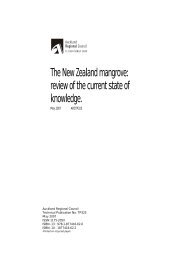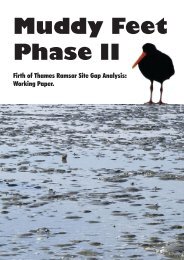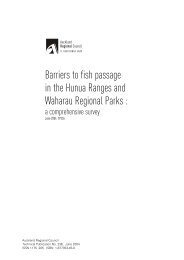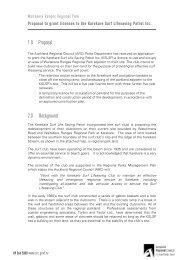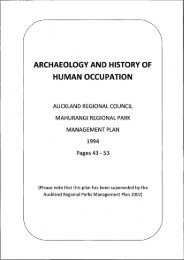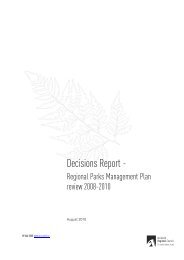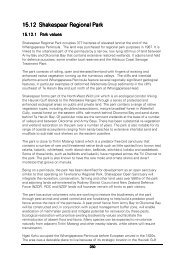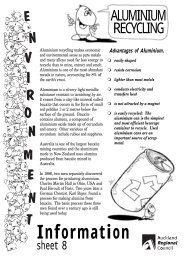Miranda (Pukorokoro), is one of New Zealand's most - Auckland ...
Miranda (Pukorokoro), is one of New Zealand's most - Auckland ...
Miranda (Pukorokoro), is one of New Zealand's most - Auckland ...
Create successful ePaper yourself
Turn your PDF publications into a flip-book with our unique Google optimized e-Paper software.
Muddy<br />
Feet<br />
Protecting the internationally important coastal<br />
environment <strong>of</strong> the southern Firth <strong>of</strong> Thames
The coastline <strong>of</strong> the southern Firth <strong>of</strong> Thames, centred at<br />
<strong>Miranda</strong> (<strong>Pukorokoro</strong>), <strong>is</strong> <strong>one</strong> <strong>of</strong> <strong>New</strong> Zealand’s <strong>most</strong><br />
important sites for shorebirds. It <strong>is</strong> an area <strong>of</strong> both national<br />
and international significance, supporting thousands <strong>of</strong> birds<br />
that migrate from their Arctic breeding grounds every year. It<br />
also has <strong>one</strong> <strong>of</strong> the world’s <strong>most</strong> significant examples <strong>of</strong> a<br />
chenier plain – a series <strong>of</strong> shell ridges which have built up over<br />
the last 6000 years. The coastline here <strong>is</strong> recogn<strong>is</strong>ed as an<br />
internationally important wetland under the Ramsar Convention.<br />
The Ramsar site plays host to more than 20,000 migratory<br />
seabirds and waders per year, many flying up to 12,000 km<br />
from the northern hem<strong>is</strong>phere to reach our shores. It <strong>is</strong> a<br />
sanctuary for over 49 different bird species, including, <strong>most</strong><br />
abundantly, the bar-tailed godwit and the red knot. The godwit <strong>is</strong><br />
also found in other parts <strong>of</strong> the Coromandel peninsula.<br />
The coastal wetlands and associated tidal area at <strong>Miranda</strong> also<br />
provide important food and habitat for the pied oystercatcher<br />
and the wrybill, which return after breeding in the South Island.<br />
Other birds breed at <strong>Miranda</strong> including three species that only<br />
live in <strong>New</strong> Zealand (the <strong>New</strong> Zealand dotterel, the variable<br />
oystercatcher and the black-billed gull).<br />
What has ‘Muddy Feet’ achieved<br />
so far?<br />
The future <strong>of</strong> the Ramsar site as a haven for birds <strong>is</strong> constantly<br />
under threat, largely as a result <strong>of</strong> human activity. Government<br />
and non-government agencies, along with iwi, are working<br />
together to identify and address r<strong>is</strong>ks to th<strong>is</strong> ecologically<br />
important environment as part <strong>of</strong> the Muddy Feet project. As a<br />
community, we can make a huge difference to the future <strong>of</strong> the<br />
Ramsar site. Through small actions we can ensure th<strong>is</strong> important<br />
sanctuary <strong>is</strong> protected for generations to come.<br />
Working with agencies and the community, the Muddy Feet<br />
project has identified the values <strong>of</strong> th<strong>is</strong> special site along with the<br />
threats to these.<br />
Photo: waen, Flickr
What <strong>is</strong> a RAMSAR site?<br />
Ramsar <strong>is</strong> the name <strong>of</strong> a town in Iran where leaders gathered for an initial meeting<br />
about wetlands that were deemed internationally important. They developed the<br />
Ramsar Convention – an international treaty which supports the conservation and<br />
sustainable use <strong>of</strong> wetlands and recogn<strong>is</strong>es their ecological, economic, cultural,<br />
scientific and recreational values. Wetlands that are recogn<strong>is</strong>ed as globally<br />
important under th<strong>is</strong> agreement are deemed Ramsar sites. There are six such<br />
wetlands in <strong>New</strong> Zealand, <strong>one</strong> <strong>of</strong> which <strong>is</strong> the Firth <strong>of</strong> Thames site.<br />
<strong>Miranda</strong> and its coast have experienced significant changes in<br />
the past including:<br />
• major accumulations <strong>of</strong> mud<br />
• an expansion <strong>of</strong> mangroves<br />
• weed infestation<br />
• an increase in predators<br />
• human activity, such as the use <strong>of</strong> land for grazing,<br />
drainage, infilling and stop-banking.<br />
The spread <strong>of</strong> mangroves and weeds <strong>is</strong> reducing the habitat for<br />
birds, while sedimentation and contaminants such as bacteria,<br />
nutrients and heavy metals entering the ecosystem are creating<br />
other r<strong>is</strong>ks.<br />
In the future, th<strong>is</strong> precious ecosystem faces even greater pressure<br />
from run-<strong>of</strong>f <strong>of</strong> mud and nutrients from the land, further<br />
mangrove expansion taking up critical roosting and nesting<br />
grounds, contaminants from agriculture and damage by<br />
stop-banking, drainage and infilling, sewage, stormwater,<br />
invasive (weed) species, potential oil spills, over-f<strong>is</strong>hing and sea<br />
level r<strong>is</strong>e.<br />
The combined effects <strong>of</strong> all these could seriously degrade th<strong>is</strong><br />
special place and the bird species – some <strong>of</strong> which are already<br />
endangered – that rely upon it.<br />
The project recommends that emphas<strong>is</strong> should be given to<br />
identifying and implementing on-the-ground actions to protect<br />
and restore the internationally important ecosystem – and that<br />
th<strong>is</strong> work should be built around active partnership with all<br />
concerned stakeholders. Managing the r<strong>is</strong>ks to the Ramsar site<br />
will benefit not only the site itself, but also ensure that the entire<br />
Firth <strong>of</strong> Thames (a high use area for commercial and recreational<br />
f<strong>is</strong>heries, aquaculture and coastal development) <strong>is</strong> well protected.
How did things get like th<strong>is</strong>?<br />
We need to go back 150 years to see why th<strong>is</strong> area <strong>is</strong> suffering today. The<br />
majority <strong>of</strong> the sediments that threaten the site were deposited there following<br />
the clearfelling and burning <strong>of</strong> the land on the Hauraki Plains in the mid-1800s.<br />
The effect <strong>of</strong> th<strong>is</strong> worsened with the construction <strong>of</strong> stop banks in the early<br />
1900s for farming.<br />
Contaminants are generally at low levels within the site, apart from mercury<br />
at the Piako River mouth, which <strong>is</strong> thought to be from the drainage <strong>of</strong> peat<br />
wetlands in the catchment.<br />
At first contact between Maori and Europeans, much <strong>of</strong> the land between the<br />
river and the foothills on the eastern bank <strong>of</strong> the Waihou River was cleared. The<br />
extensive coastal plains <strong>of</strong> the sourthern Firth <strong>of</strong> Thames were recogn<strong>is</strong>ed by<br />
Captain Cook and Joseph Banks in 1769 as “a garden and a pasture in which<br />
the best elements <strong>of</strong> Brit<strong>is</strong>h society might grow into an ideal nation”, in spite <strong>of</strong><br />
being blanketed at the time by a vast kahikatea forest containing the biggest<br />
trees they had ever seen (Park 1995).<br />
<strong>Miranda</strong> Natural<strong>is</strong>ts’ Trust<br />
<strong>Miranda</strong> Shorebird Centre<br />
D I S T R I C T C O U N C I L<br />
Environment Waikato’s freeph<strong>one</strong> 0800 800 401 www.ew.govt.nz
We now know what action we need to take to<br />
minim<strong>is</strong>e the r<strong>is</strong>ks to the Firth <strong>of</strong> Thames site. The<br />
good news <strong>is</strong> that our analys<strong>is</strong> shows good policy<br />
and work programmes are in place to address all<br />
<strong>of</strong> the important <strong>is</strong>sues relating to land run-<strong>of</strong>f, with<br />
opportunities to further improve the effectiveness<br />
<strong>of</strong> th<strong>is</strong> by working with land owners on innovative<br />
solutions.<br />
Following are some <strong>of</strong> the main actions that will<br />
contribute to the future livelihood <strong>of</strong> the Ramsar site.<br />
Marine biosecurity and harvesting<br />
(Central government agencies)<br />
• Carry out r<strong>is</strong>k assessments for known and<br />
potential invasive species.<br />
• Implement monitoring <strong>of</strong> transfer <strong>of</strong> marine<br />
farming gear between water bodies to reduce<br />
the spread <strong>of</strong> invasive species.<br />
What you can do<br />
• Camp, walk and tramp only in signposted areas.<br />
• Fence cattle and avoid grazing stock on stopbanks.<br />
• Consult regional council guidelines on land<br />
d<strong>is</strong>turbance activities before you commence.<br />
• Only take dogs for a walk in approved areas and<br />
keep them on a lead at all times.<br />
• Thoroughly clean and dry all boating/marine<br />
equipment to help prevent the spread <strong>of</strong> invasive<br />
species.<br />
Fundamental research (universities, CRIs)<br />
• Develop a general ecosystem understanding.<br />
Legend<br />
Kaiaua<br />
Catchment Marine farm<br />
Intertidal<br />
Mangroves<br />
Rocky reefs<br />
State highway<br />
Subtidal



